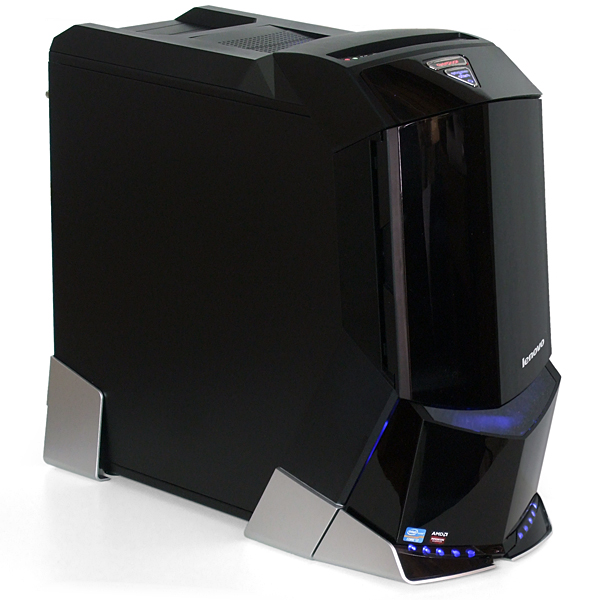Lenovo Erazer X700 Gaming PC Review: Is It As Fast As It Looks?
Famed for its ThinkPads, data center-oriented servers, and dependable office PCs, Lenovo is looking to carve out a piece of the enthusiast segment with its Erazer X700 gaming system. Can this sexy-looking setup stand up against our SBM configurations?
Is Lenovo's Erazer X700 The Perfect Gaming Workstation?
Lenovo’s products are most familiar to mobile and business users. But the enthusiast segment is tougher to crack. To begin with, many of us prefer configuring our hardware choices, dialing in an optimal balance between complementary components. Those of us with more money than time are typically willing to pay specialized boutiques to build those very custom PCs. But the business strategy that bore Lenovo's Erazer is very unlike those boutiques it needs to contend with.
The X700 we have in our lab isn’t your grandma’s Aptiva, and Lenovo hopes to set it apart from those office-inspired systems with a gaming-inspired exterior. Inside, the Erazer still looks like the IntelliStation that likely hatched her, however, with a workstation-oriented motherboard and processor you would expect to find in the firm’s ThinkStation line. Thankfully, Lenovo complements its gamester chassis with a real gaming graphics card and some headroom for overclocking.
| Lenovo Erazer X700 PC Configuration 57316913 | |
|---|---|
| Configurable Components | |
| CPU | Intel Core i7-3930K (Sandy Bridge-E): 3.2-3.8 GHz, Six Cores, 12 MB Cache |
| DRAM | 4 x Hynix HMT451U6AFR8C DDR3-1600 C11, 16 GB (4 x 4 GB) |
| Graphics | AMD Radeon HD 8950 OEM, 3 GB GDDR5 |
| System Drive | Samsung 830 MZ7PC128HAFU 128 GB SATA 6Gb/s SSD |
| Storage Drive | Seagate Barracuda ST2000DM001 2 TB, 7200 RPM Hard Drive |
| Wireless Network | Realtek RTL8188CE 802.11b/g/n single-channel PCIe, 150 Mb/s |
| Chassis | |
| Model | Lenovo X7 series ATX Mid-Tower |
| Expansion Slots | Seven |
| Internal Bays | 4 x 3.5" / 2.5" Trays, 2 x Front-Loading 3.5" / 2.5" Docks |
| Power Bay | PS/2, Top Mounted on Rear Panel |
| External Bay | 5 x 5.25" (Three Filled), 1 x 3.25" (Filled) |
| Front Panel I/O | 1 x USB 2.0, 1 x USB 3.0, Headset (Top Panel,) SD/MMC/XD/MS PRO/CF Flash Media Interface (3.25" bay) |
| Fans | 1 x 120 mm Intake, 1 x 120 mm Exhaust |
| Dimensions | 20.9" (H), 10.6" (W), 24.0" (D), 61.7 Pounds |
| Motherboard | |
| Model | Lenovo 10122: LGA 2011, Intel X79 Express, MicroATX |
| External Data | 6 x USB 2.0, 2 x USB 3.0, 1 x Gigabit Ethernet |
| External Audio | 6 x Analog, Digital Optical, Digital Coaxial |
| External Video | None |
| Internal Ports | 4 x SATA 6Gb/s, 4 x SATA 3Gb/s, 2 x USB 3.0, 6x USB 2.0 |
| Internal Slots | 2 x PCIe x16, 2 x PCIe x1 |
| Maximum Memory | 4 x DDR3-800 to DDR3-1600 (all standard capacities) |
| Gigabit Ethernet | Realtek RTL8168B PCIe, 10/100/1000 Mb/s |
| Audio Controller | Realtek ALC892 DAC, 7.1 + 2-Channel rear/front audio |
| Other Features | |
| Optical Drive | PLDS DH12B2SH 12x BD-R (16x DVD±R) |
| Power Supply | AcBel FS8003 625 W, 80 PLUS Gold, 2 x Six-Pin / 2 x 6+2-Pin PCIe |
| Cooling | Asetek 120 x 38 mm closed-loop, 60 mm PWM, 40 mm PCH |
| Warranty | One Year Standard, Extendable to Three Years |
| Software | Windows 8 OEM, PowerDVD 10, Power2Go v6, TriDef 3D |
| Price | $2300 |
Observant enthusiasts will note that the Core i7-3930K is really best-suited for work duty, since most games max out around four cores. Less expensive LGA 1150-based processors offer higher IPC (instruction per cycle) throughput, lower power consumption, and fit onto more affordable motherboards. But Lenovo’s platform offers sixteen lanes of PCI Express connectivity to two add-in cards if you’re itching to support upgrades, and its combination of extra RAM and storage could make it the all-around winner that our previous System Builder Marathon $2550 machine tried to be.
Get Tom's Hardware's best news and in-depth reviews, straight to your inbox.
Current page: Is Lenovo's Erazer X700 The Perfect Gaming Workstation?
Next Page Getting To Know Lenovo's Erazer X700-
larsoncc I won the $2550 computer featured in the Q3 SBM Marathon. I believe their scores using that system were 'slightly' hampered by fact that one of the 760s that was going bad. After RMA'ing the card, and using the same overclocks as featured in the SBM article, as well as moving the system to a high airflow case (Corsair Carbide Air 540) the 3DMark score is 19,100 (http://www.3dmark.com/3dm11/7455484). Thanks Tom's!Reply -
chumly wtf resolutions are you testing? How about 1440p? Hardly ANYONE uses dual/triple monitor setups because the framerate sucks so entirely and 99% of the people on the planet don't have $5k to throw at a gaming PC. you are wasting your time. give us SINGLE monitor configs, for the love of god.Reply -
dudewitbow Reply12040927 said:....and wth is an HD 8950?!?!?!
HD 8XXX cards are rebranded 7XXX cards for OEMS to use for marketing, cause you know, uninformed Consumers love to think that larger number means better and that new products(despite not really being new) convinces them to buy it. an 8950 should be a rebranded 7950 -
SWEETMUSK the case is looking cool but,why they set the power at top?the power can't be hot it should set under the case and video card is not goodReply -
m32 They could've put a R9 280x in it, but this isn't meant for the guys on this site. This is meant for sucke...... cough..... the average consumer.Reply

